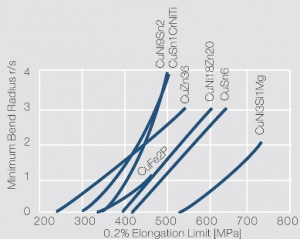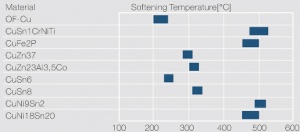Application Properties for the Selection of Copper Alloys
5.1.7.1 Spring Bending Limit
The spring bending limit is defined as the boundary condition under which a standar-dized spring sample retains a deformation of 0.05 mm after initial bend stressing and subsequent force removal. The measurement is performed according to the standard EN 12384. The spring bending limit is strongly dependent on the direction of stressing with regard to the strip rolling orientation Figure 1 (Fig. 5.38). Higher values are obtained if bending is perpendicular to the rolling direction as compared to parallel. This has to be considered when designing contact springs.
5.1.7.2 Fatigue Strength
The fatigue strength is a measure of maximum alternating bending force, symmetrical to the zero position, which a sample – for example a relay spring – can be exposed to for an “unlimited” number of cycles without breaking. (Rule of thumb: Fatigue strength = 1/3 of Tensile strength). The measurement is conducted using so-called Woehler– diagrams . With increasing bending force 7 the number of alternating cycles before breaking decreases. Above 10 cycles the influence of further cycling numbers becomes insignificant and therefore 7 the force value reaching 2x10 cycles can be used to define the fatigue strength. The multi-component alloys CuZn23Al3.5Co and CuSn1CrNiTi show high values of fatigue strength while CuFe2P and CuZn30 exhibit low ones (Figs. 2 – 3) (Figs. 5.39 and 5.40).
Figure 2 Fig. 5.39: Woehler curves for selected copper based materials. Strip samples: 0.3 mm thick, cold worked; Testfrequency; 1,500 / min (Wieland)
Figure 3 Fig. 5.40: Ranges of fatigue strength for selected copper materials (Wieland)
5.1.7.3 Bendability
The measure for bendability of a strip material is the smallest possible bending radius r of a sample piece of given material thickness s without appearance of surface cracking. Bending tests are performed as either 90 degree bends according to ISO 7438 or as defined forth-and-back bending. The bendabilty of naturally hard copper alloys is significantly better perpendicular to the rolling direction than parallel to it (Figs. 5.41 and 5.42).
Fig. 5.41: Smallest possible bend radii for 90° bends as a function of the 0.2% yield strength R – bend line p0.2 perpendicular to the rolling direction (Wieland)
Fig. 5.42: Smallest possible bend radii for 90° bends as a function of the 0.2% yield strength Rp0.2 – bend line parallel to the rolling direction (Wieland)
5.1.7.4 Softening Behavior
Through thermal activation at elevated temperatures the original mechanical material strength achieved by cold working or precipitation hardening can be reversed completely. The start of softening is mostly defined as the temperature at which a 10% reduction of mechanical strength is reached. It is dependent on the degree of initial cold working and the annealing temperature and time. For higher initial degrees of cold working degrees the softening temperature becomes lowered. As expected, the softening temperature for pure copper is rather low. CuNi9Sn2 and CuSn1CrNiTi exhibit high softening temperatures (Fig. 5.43).
Fig. 5.43: Softening behavior for selected copper-based materials after 40% cold working (Wieland)
5.1.7.5 Relaxation Behavior
Tension relaxation is defined as the loss of tension of an elastically stressed material as a function of time and temperature. The causes for the relaxation are thermally activated processes which are comparable to creep behavior. As a measure for the relaxation the percentage decrease in the bending tension compared to the initial one is used. Temperature increase is a stronger influencing factor on the relaxation of the spring force than growing operational times. Through suitable annealing processes the relaxation degree can be significantly reduces. For the measurement of tension relaxation different test procedures are used, based on the ASTM E-32-86.
Fig. 5.44 illustrates the different relaxation behavior of some copper alloys. Good behavior is shown for CuNi3Si1Mg and CuCrSiTi while CuZn30 and CuSn6 exhibit a less favorable relaxation tendency.
Fig. 5.44: Relaxation behavior of selected copper-based materials. Starting tension: 100% of spring bending limit; Stress duration: 100 hrs (Wieland)






